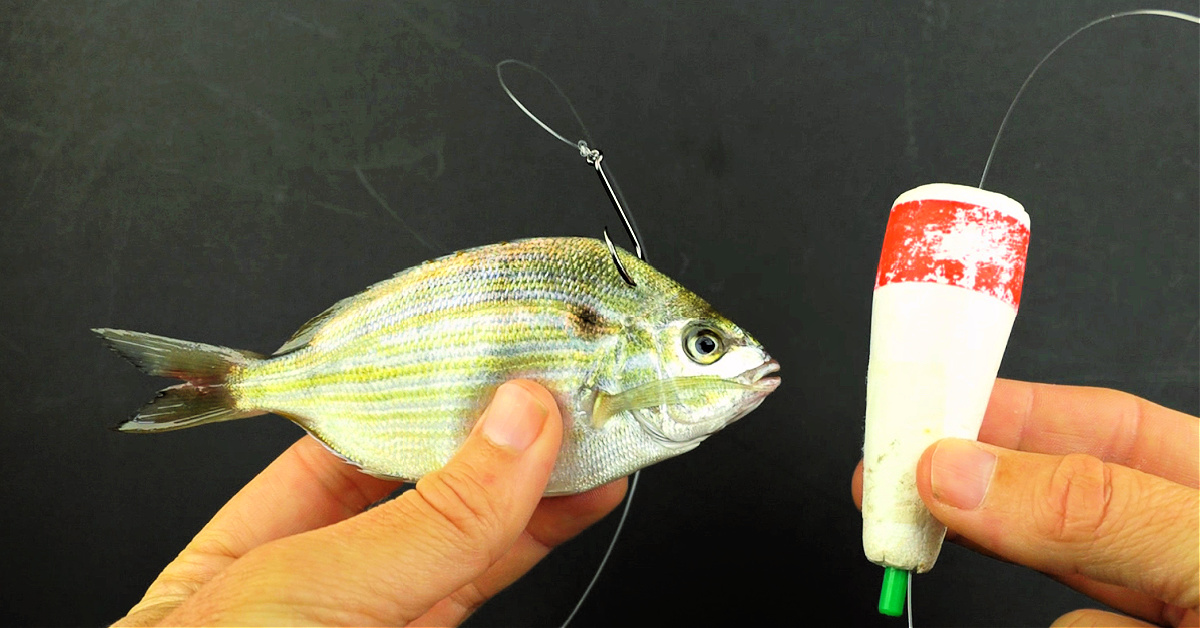3 Things You Need To Know When Using Live Pinfish On Grass Flats
- By: Luke Simonds
- on

“Presentation is key.”
You’ve probably heard that a thousand times and guess what, it’s true!
In this video, you’ll learn how to catch fish with live pinfish over grass flats, and how simple changes to your set-up can be the difference between a great day on the water and getting skunked.
Watch this video and learn the best way to:
- Rig a live pinfish when fishing grass flats (and why pinfish are unique here)
- Cast live bait so that they last longer
- Attract more fish to your bait
- And more
Check it out below!
How To Use Live Pinfish On Grass Flats [VIDEO]

Rigging
Since presentation is key, you’ll want to rig up your pinfish so that it moves through the water naturally.
You have two options when hooking pinfish:
- Hook the pinfish through the meat section between the eyes and the dorsal.
- Hook the pinfish through the mouth starting from the bottom and going through both lips.
Another thing to note is that you want the cork to suspend the pinfish just above the grass.
Adjust your bobber depending on the depth of water you are fishing in.
If your leader is too long underneath the float, the pinfish will bury itself in the grass and you likely won’t catch anything.
Casting
The goal here is to keep the pinfish alive, so you’ll want to take it out of the water as little as possible.
Get the bait behind you while keeping it in the water, then lift it up, and lob it out!
Work the Flats
Drift, pop, repeat.
Let the wind and current drift the pinfish over the grass flats.
Get the line tight every once in a while during the drift and give the bobber some pops to mimic the sound of a fish that is eating something from the surface.
Let the bobber and the circle hook do the work for you.
Once you see the bobber go under the water, keep your rod tip down and just start reeling.
(Remember to not set the hook if you’re using a circle hook!)
Perform a little CPR (that’s Catch. Photo. Release.) and get back to fishing!
My Favorite Tackle For This Scenario
I mentioned that there are some specific terminal tackle items that are a must when fishing with live pinfish.
Check out these options for your next trip:
The popping float is a key element but you don’t need to worry about using one if you have live mullet or pilchards because they won’t dig into the grass like pinfish do.
And make sure you get a bobber with a concave top so that when you pop the float, it creates the feeding noise to attract other fish.
Just like fishermen attract other fishermen, feeding fish attract other fish!
Common Mistakes
Whether you are new to fishing or a pro, we all are guilty sometimes of moving too fast or not using the right tackle for the situation.
Here are 3 common mistakes when using pinfish on grass flats:
- Setting the hook when using a circle hook.
- Reeling in your bait too fast.
- Not using a bobber.
Resist the urge to set a circle hook on a fish otherwise you may end up yanking it right out of its mouth. Just start reeling!
If you are moving spots or re-casting, do not reel in too fast.
That slow retrieve keeps the pinfish swimming naturally and you have a good chance of a strike.
And make sure you always use a bobber with your live pinfish over the grass flats.
Pinfish want to bury down into the grass, but the bobber will keep them hovering just over the grass and in clear view of predator fish.
Conclusion

When fishing with live pinfish on the grass flats, it’s all about presentation.
You want the bait to look natural, and a bobber can make sure it doesn’t swim down and hide in the grass.
What is your live pinfish setup?
Do you have any questions about this rig?
Let me know down in the comments.
Know someone who loves to use live pinfish for bait? Please TAG or SHARE this with them!
P.S. Want access to our best fishing spots and tips, plus discounts to our online tackle store? Click here to join us in the Insider Club!
Related articles:
- LIVE BAIT RIGS: BEST OVERALL RIG FOR INSHORE FISHING (AND THE WORST RIG)
- TOP 3 LIVE BAIT RIGGING MISTAKES (UNDERWATER EVIDENCE)
- HOW TO CHOOSE THE BEST POPPING CORK (AND LURE) FOR EVERY CONDITION
Disclaimer: When you buy through links on our site, we sometimes earn affiliate commission from places like Amazon, Bass Pro, Tackle Warehouse, etc. It’s one more way we can help you quickly find the best deals on the web while making sure we’re still around to serve you for years to come (and you do want us to be around to help you catch fish for many more years, right)?
Related categories:
STOP WASTING TIME ON THE WATER!
Do what the “SMART ANGLERS” are doing and join the Insider Club.
Here’s what you’ll receive today when you join:
- Weekly fishing reports and TRENDS revealing exactly where you should fish every trip
- Weekly “spot dissection” videos that walk you through all the best spots in your area
- Exclusive fishing tips from the PROS you can’t find anywhere else
- Everything you need to start catching fish more consistently (regardless if you fish out of a boat, kayak, or land).










Did you cut off the dorsal fin on the pinfish?
Great Vid Luke. Heading to the keys for the end of the Tarpon migration, will definitely put the rig to use.
Thanks
Thanks Gary! I hope you have a blast down in the Keys.
Why is setting the hook with a circle hook bad? Is that why I’m missing some when they strike?
Circle hooks need time to slide into place, so setting the hook typically does more harm than good. Instead, just reel in the line and the hook will have a better shot at sliding into place in the corner of the fish’s mouth.
Thanks for the tips on using pinfish as bait Luke. One of the things I often hear is you should trim the back fin off the pinfish off when using them for bait. I noticed that you did not with your approach which presents the bait naturally. Are there legitimate applications for trimming the fins off a pinfish, or is trimming the back fin down more to protect the fisherman?
I have heard of people cutting the tail fin down so that the bait can’t move as fast and so it gives off more scent in the water. That’s perhaps helpful for redfish, but I think it’ll decrease the odds of snook and trout which are more sight/action focused vs. scent focused like redfish. Also, I was relying on the baitfish to swim around and cover more water in this case so trimming the tail would have done more harm than good.
I use scissors to trim the dorsal fin off the pin fish because I believe it makes it easier and quicker for the fish to turn the bait and get it in his mouth. I can’t prove it but I seem to get more hookups this way. Your thoughts?
How do you rig up the popping cork
Here’s a video showing how to use these types of popping corks: https://www.saltstrong.com/articles/how-to-rig-a-popping-cork-with-a-slit/
I was searching for this info today, then I got the email, imagine that! I have caught reds drifting pinfish across a flat with a cork.
Why do people hook bait fish through the lips or towards the head, when predator fish, typically eat bait head first? I’m trying to understand that. I figure tail hooking would be better if your drifting bait?
The reason to hook pinfish through the mouth is to make sure the baitfish looks/swims natural when getting moved by the current and/or when reeling in the bait in for the next cast.
Hooking towards the tail has the advantage when fishing areas with low current flow when you’re in need of the baitfish swimming around to cover ground.
I like the other option you demoed for how to rig pinfish- nice
Thanks!
i really like your instructional style. Very informative and relaxed. And your fishing IQ, passion and respect for the fish come thru in the videos. Now I want to get some pinfish and give it a try.
Thanks Ray!
That was a good tip I didn’t know
Thanks Jose!
Very informative. Thanks for breaking it down.
Thanks Luke!